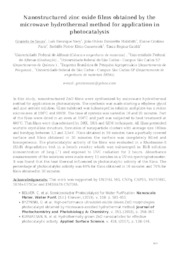Nanostructured zinc oxide films obtained by the microwave hydrothermal method for application in photocatalysis.
Nanostructured zinc oxide films obtained by the microwave hydrothermal method for application in photocatalysis.
Author(s): SOUZA, G. de; NERY, L. H.; PARIS, E. C.; KLEIN-GUNNEWIEK, F.; GIRALDI, T. R.
Summary: In this study, nanostructured ZnO films were synthesized by microwave hydrothermal method for application in photocatalysis. The synthesis was made starting a ethylene glycol and zinc acetate solution. Glass substract was submerged in solution and place em a reator microwaves at 180oC and 600W. The time of syntesis was varied in 10 and 30 minutes. Part of the films were dried in an oven at 100oC and part was subjected to heat treatment at 600oC. This films were characterized by DRX, DRS and SEM techniques. All films presented wurtzite crystalline structure, formation of nanoparticle clusters with average size 100nm and bandgap between 3,3 and 3,5eV. Films obtained in 10 minutes have a partially covered surface and films obtained in 30 minutes the surface was completely filled and homogeneous. The photocatalytic activity of the films was evaluated in a Rhodamine-B (RhB) degradation test in a bench reactor which was submerged in RhB solution (concentration of 5mg.L-1) and exposed to UVC radiation for 2 hours. Absorbance measurements of the solutions were made every 15 minutes in a UV-vis spectrophotometer. It was found that the heat thermal influenced in photocatalytic activity of the films. The percentage of photocatalytic activity was 69% for films obtained in 10 minutes and 76% for films obtained in 30 minutes
Publication year: 2022
Types of publication: Abstract in annals or event proceedings
Unit: Embrapa Instrumentation
Keywords: DRX, Hydrothermal method
Observation
Some of Embrapa's publications are published as ePub files. To read them, use or download one of the following free software options to your computer or mobile device. Android: Google Play Books; IOS: iBooks; Windows and Linux: Calibre.
Access other publications
Access the Agricultural Research Database (BDPA) to consult Embrapa's full library collection and records.
Visit Embrapa Bookstore to purchase books and other publications sold by Embrapa.

